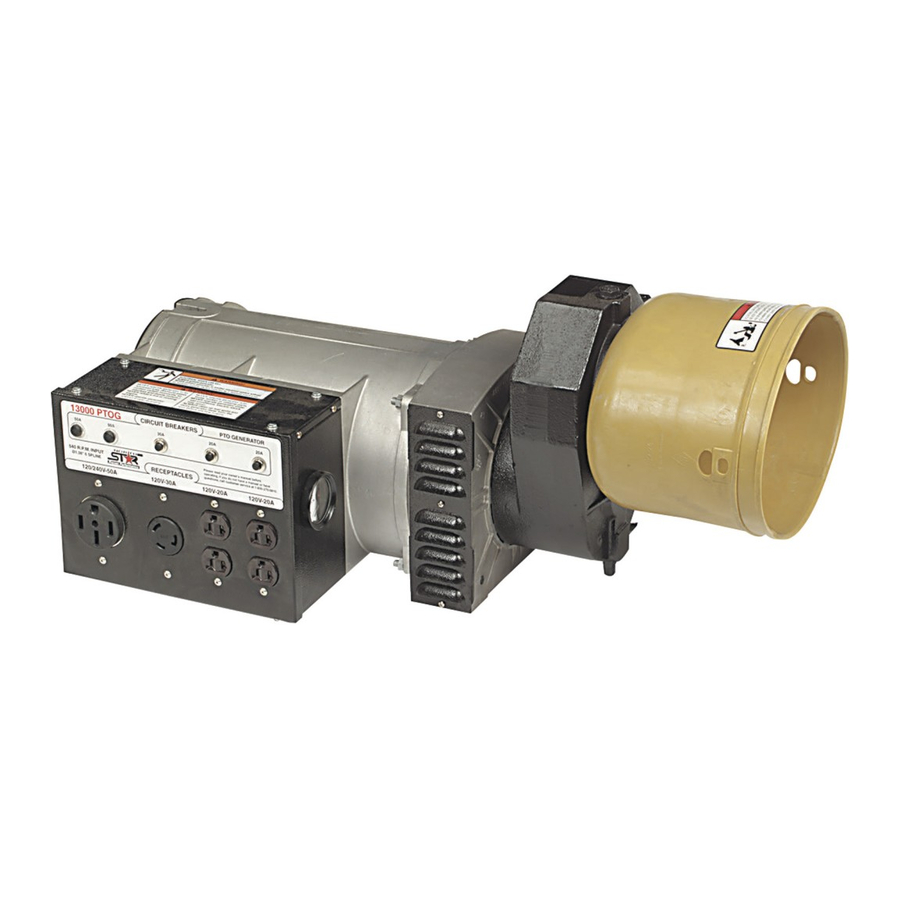
Table of Contents
Advertisement
Advertisement
Table of Contents

Summary of Contents for North Star 13000 PTOG
- Page 1 MODEL 13000 PTOG ITEM # 165929 Power Take-Off Generator P r o v e n P e r f o r m a n c e M165929A OWNER’S MANUAL 00293 13000 PTOG Any Questions, Comments, or Problems? Call Customer Service at 1-800-270-0810...
-
Page 2: Table Of Contents
Thank you for purchasing a NorthStar Power Take-Off Generator. designed for long life, dependability, and the top performance you demand. Please take time now to read through this manual so you can better understand the machine’s operation, maintenance and safety precautions. Everyone who operates this generator must read and understand this manual. -
Page 3: Specifications
SPECIFICATIONS Item Number Maximum Output Continuous Output Voltage Phase Frequency Power Factor Minimum PTO HP Input Shaft 120V Receptacle 120/240V Receptacle Circuit Breaker Gear Box Gear Ratio Gear Oil Oil Capacity Dimensions Length Width Height Gross Weight ANSI SAFETY DEFINITIONS DANGER indicates an imminently hazardous situation which, if not avoided, will result in death or serious injury. -
Page 4: Machine Component Identification
MACHINE COMPONENT IDENTIFICATION Ref. Description 50A Circuit Breakers 30A Circuit Breaker 20A Circuit Breakers Warning Decals 1 3/8”, 6 Spline Input Shaft Oil Drain Plug Voltmeter 120V 20A Duplex Receptacles 120V 30A Twistlock Receptacle Figure 1 (Ref. 1-10) Ref. Description 120/240V 50A Receptacle Shield Gear Box... -
Page 5: Generator Features
GENERATOR FEATURES References 1-3 Circuit Breakers. • Reference 1 - two 50A push-to-reset circuit breakers. • Reference 2 - one 30A push-to-reset circuit breaker. • Reference 3 - two 20A push-to-reset circuit breakers. References 4 - Warning Decals. follow all warnings. References 5 - 1 3/8”... -
Page 6: Introduction
Reference 17 - Breather/Oil Fill Plug. SAE 90 gear oil. Maintain the correct oil level. Over filling can cause the oil to over heat and damage seals and bearings. shipped with temperary plastic plug, remove and replace with the metal breather plug that is in the manual bag. -
Page 7: Installation
Choose a location where the generator will not be exposed to rain, snow or direct sunlight. Common places for mounting your PTO generator are to a trailer or a cement slab. choose to mount the generator, make sure it can get as close to the load as possible. -
Page 8: Starting Electric Motors
LOAD APPLICATION It is important to determine the total electrical load before it is connected to the generator. two major factors in determining the life of a generator head are: heat build up, caused by overloading generator contaminants, that attack the wiring insulation. If the generator is overloaded, the wires become excessively hot and cause the insulation to break down, reducing its ability to... -
Page 9: Extension Cords
as the electric motor windings. Because the heavy surge of current is required for only an instant, the generator will not be damaged if it can bring the motor up to speed in a few seconds. If difficulties in starting a motor are experienced, turn off all other electrical loads and if possible reduce the load on the electric motor. -
Page 10: Generator Care
GROUNDING - All units must be grounded. Drive a 3/4” or 1” copper pipe or rod into the ground close to the generator. The pipe/rod must penetrate moist earth. Connect an approved ground clamp to the pipe. Run a 8 gauge wire from the clamp to the generator ground screw. -
Page 11: Troubleshooting
Problem Possible Causes Voltage too low. Circuit breaker trips. generator. c) Generator overloaded. d) Defective circuit breaker. Voltage too high. Generator overheating. No output voltage. generator. c) Defective receptacle. f) Defective capacitor. h) Engine speed too slow. PTO not engaged. Gear box is malfunctioning.







Need help?
Do you have a question about the 13000 PTOG and is the answer not in the manual?
Questions and answers